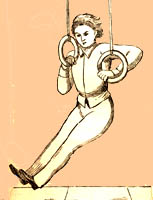 |
Climbing and Gymnastics A Historical Association |
 |
Climbing and Gymnastics A Historical Association |
|
Why Include the Rings? Simply because I worked the apparatus when I was young, along with gymnastic rope climbing for speed. Although I found these two events - for me - had the greatest carry-over value for rock climbing, I did them primarily because I enjoyed the pure gymnastics. The rings are THE strength apparatus, but they also call for balance, timing, and endurance. Still rings require great physical discipline - smoothness and control under extreme tension. |
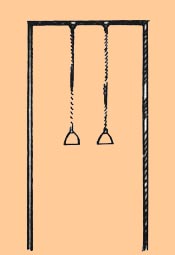 Ringeschwebel: from an 1842 handbook |
The Beginning
. . . Jahn's and Muths' gymnastic programs, developed in the early 1800s, included much of the modern apparatus now used in men's international competition - except the Still Rings. Although Roman Rings date back two thousand years, Jahn failed to include them in his program. Adolf Spiess (1810-1858) introduced what he called Ringeschwebel in 1842, with metal stirrups. At some later date circular rings replaced the original version. Over the years rings have been made of metal, leather-covered metal, rubber-covered metal, and finally the wood laminated rings used today. Spiess's concept included a swinging motion - later called the flying rings. The swinging variety vanished from collegiate circuits in the 1960s, however. When I first began working the rings in 1954, flying rings was still a gymnastic event in the southern United States, and I got a little flight time on them. |
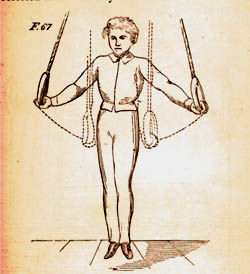 Lewis was proprietor of the Essex Street Gymnasium, Boston, and was in charge of gymnastics at the prestigious Normal Institute for Physical Education. |
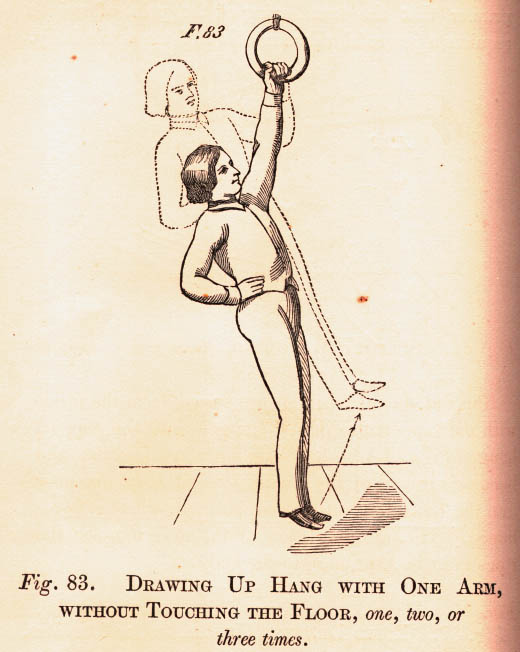 The rings are part of an apparatus called the Pangymnastikon (see below) |
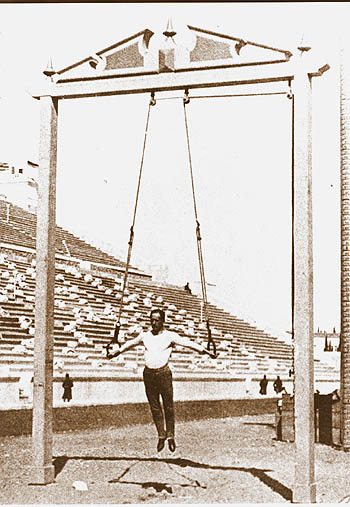 The 1896 Olympic Stadium in Athens |
| As
the Soviets rose to
gymnastic prominence in the early 1950s,
Albert
Azaryan of Armenia was the world's greatest still ring
performer. He took the gold in two Olympic games. Here he does an Olympic Cross,
probably as part of his eponymous sequence which
consists of an olympic in one direction followed immediately by a
second facing the other way, then back to a regular cross and pull out
to support. His control was spectacular. It was while watching a movie newsreel of Azaryan in 1954 that I became convinced that rock climbing should be viewed as a form of gymnastics, and that developing that kind of strength would elevate climbing standards substantially. (After several years, I was able to do an Azaryan - but not as well as the Master!) |
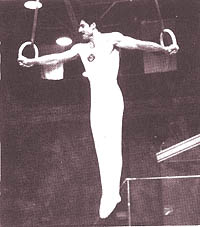 |
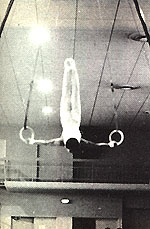 Inverted Cross (1960) Japanese Performer |
Mark Gildon doing a Maltese Cross at Muscle Beach in the mid 1950s. Mark was a national AAU rings champion. |
| The
Rating Structure in Gymnastics In the 1950s, there were three classifications of difficulty: A (easiest), B, and C (hardest). Now there are: A, B, C, D, E, and Super-E. A Handstand on the rings was an A move. A Cross was a B move, as was a Front Lever. An Inverted Cross was a C move, as was a Maltese Cross, and an Azaryan. There were difficult swing moves as well: a Back-uprise to Handstand was a C move (2004-B), as were Giant Swings in both directions. The easiest way for a gymnast to go from a hang to a Handstand was a Peach Basket (1958-B): pike in a hang, then quickly extend to an arch while pulling up. With a slight swing at the start you could avoid most of the pike and whip right up to the handstand with very little effort - but the trick looked spectacular. Of course, this was part of a front Giant Swing as well - just as the Back Uprise to Handstand was part of a back Giant Swing. Some of the Stunts I used to do in the latter 1950s as an Amateur Gymnast I wasn't genetically designed to be a gymnast. At 6'2" and 170-180 pounds, with only modest flexibility, and with most of my height in my legs, I didn't do very well on free-X or the high bar. But I was able to master some of the harder moves and sequences on the still rings. Being big and able to do some demanding stuff gracefully was unusual in an environment of 5'8" 150 pound (male) performers (5'5", 130 pound men these days). |
However, even though
I did a number of difficult lever moves with good form, I was never
able to do a really clean Planche
or Maltese Cross.
The Maltese is de rigueur for top flight ring
men these days. Gymnastics in the 1950s was a freer and more unbridled activity, relatively unrestrained by the sort of rigid though fluxuating guidelines imposed by the FIG nowadays. You were allowed to use a false grip if you wished, or to hold handstands with an arch, or to do stunts with bent arms, or to concentrate on swing moves, or on muscle moves - all of which subsequently and for varying periods of time were or are discouraged or forbidden by the FIG. I was shocked to learn recently that a Peach Basket to Handstand was not even being taught anymore. I still find that hard to believe. Tell me it's not true . . . The art work you see below is mediocre, but you'll get the idea. As far as difficulty is concerned, I got up to what was considered maximum difficulty those days on several stunts - C moves. (actually, the first mount described below is now considered a D move). This would be like a American rock climber in the mid 1950s not exceeding 5.9. But, believe me, gymnastics was more advanced than climbing at that time and, relatively speaking, the C moves were a bit more severe than the 5.9s! |
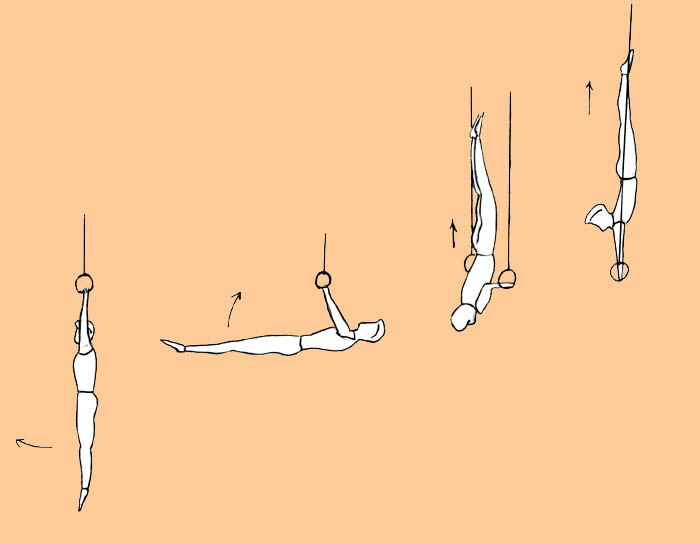 |
| Here
is one of my favorite mounts - I learned it at the University of
Chicago in 1958, assisted by Coach
Bob Kreidler : the Straight-body
Rotation into a Handstand (1958-C)
or (2004-D). Several graduates of
the University who had been active gymnasts, would come in a couple
of afternoons a week, and we'd work out together. One of them was
able to do this move - it was the first time I'd seen it and I
was
impressed! It took me a couple of weeks to master it. Starting from a dead hang - using no swing - and pulling through the front lever, the transition from a hang to a press was the hardest part for me (frame 3). This part is now called an Elevator, or an inverted muscle-up to handstand (2004-D). The mount required a false grip, and was done with virtually no momentum, in one smooth movement. On the other hand, with a good swing the mount is reduced to a Shoot to Handstand (2004-B). |
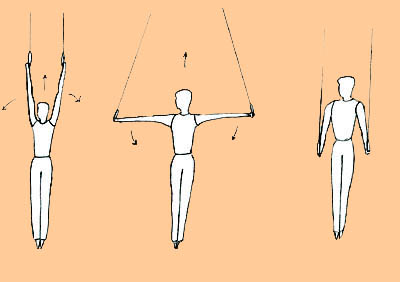 |
| This is a basic Cross mount I learned at Chicago in 1958. You start with a false grip, and power your way into a support - or you can pause in the cross position. (1958-C). I also did this mount while raising my legs into an L-position - a Butterfly mount or an L-cross mount - which was a bit easier, since you got a little upward momentum. I could do two Butterflies in a row on a good day. |
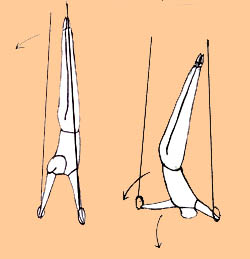 |
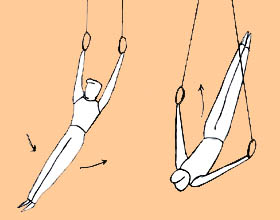 |
 |
| Here's
a Backward Giant
Swing (1958-C). I
usually lowered into a momentary Inverted
Cross before dropping. The fourth
figure is engaged in a Back
Uprise to Handstand. I never did this
really well, and was forced to pike slightly. I also had some
trouble controlling the momentum on a Front
Giant since my legs were so long,
forcing me to lower through a momentary planche before dropping - the
first time I tried the Front,
entering the swing from the handstand position, I flew off the rings at
the bottom-most point of my
swing, did a somersault and landed sitting on the mat beneath the
rings - with a sprained wrist! Practical physics . . .
|
| I did a modestly decent Inverted Cross (1958-C), lowering from a handstand. Actually, when I did this I continued, after pausing for a moment, into a Back Giant Swing, as seen above. This levered move looks horrific, but it's not impossible. I probably didn't hold the inverted cross in a perfectly flat manner, like the drawn figure - my shoulders were elevated somewhat above the horizontal. | 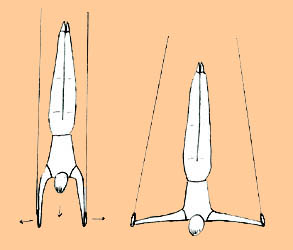 |
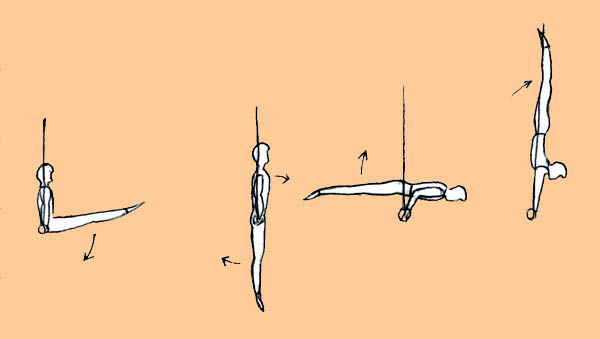 |
| From an L-position, I did a Straight Body Press to Handstand (1958-B). |
| I also did a Stiff-stiff to handstand (1958-B). Dave Rearick and I used to practice these on a cement slab at the old Climbers Campground at Jenny Lake, in the Tetons, during the very early 1960s. I taught him, and he later taught Pat Ament the trick. | 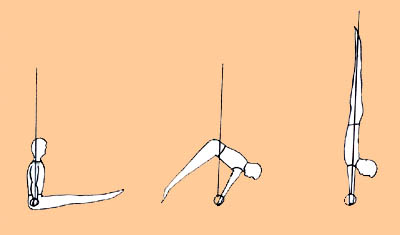 |
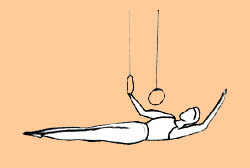 |
The One-Arm Lever. I usually did it facing a tad more to the side than the figure indicates. I've never heard of a modern still ring routine that involves turning loose one of the rings - there may be some guideline from the FIG disallowing such a thing. In any event, it would be tricky, getting back onto both rings to continue. I normally did the lever as training for climbing, on a more stable apparatus - but it can be done on the rings. One can pull directly into it from a hang, or turn loose one hand while doing a Front Lever - thus it's sometimes referred to as a One-Arm Front Lever. I could do a one-finger pull-up, so I was able to perform this lever with a single finger, as well. |
| OK,
now this lever was a conjecture
of mine in the 1950s. It's actually a Front
Lever with the body held at the level of the
rings. Or, perhaps, an Inverted
Maltese Cross.
I tried it several times, but failed. Each time I was able to lift my
body to ring height while rotating from a hang into a front lever - but
I could never hold the position more than half a second. Mark Williams,
Assistant USA Gym Coach, informs me that it was first done perhaps by a
Russian, and is called a Victorian
Cross. Watch Danny Rodrigues of France performing this most difficult stunt in a competition: Danny Rodrigues performing a Victorian during still rings competitiion |
 |
| The
Pangymnastikon . . . In the middle of the 19th century D. G. M. Schreber,MD, Director of the Medical Gymnastic Institution at Leipsic, invented an exercise device which he described in the following: "Two large hand rings suspended from the ceiling by ropes, which, running through padded hooks, are carried to the walls. Two other ropes extend from the walls directly to the hand rings. A strap with a stirrup is placed in either hand ring." Schreber then explains how the various pieces of the Pangymnastikon may be adjusted for various exercises. He continues, "Upon a close examination of the Pangymnastic exercises, the conviction will be forced upon all, that by no other means can such a variety of valuable exercises be reached." (Translation by Dio Lewis, 1862) |
 |
| These delightful little figures from the book by Dio Lewis display an interesting perspective of the desirable male physique. Upper body muscularity was considered unappealing by the upper and middle classes. Instead, masculinity was evidenced by strong and prominent buttocks, thighs and legs - the mark of aristocratic horsemanship. Compare the size of the arms of the center figure with its buttocks and thighs . . . |